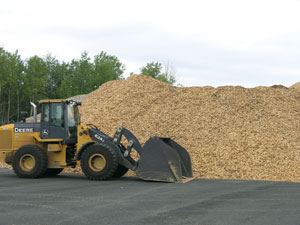
Canbio Update: Challenges for Canadian pellets
August 24, 2009
By John Swann
The year 2009 will be known as the “Best of Times and the Worst of
Times.” Canadian wood pellet manufacturers have hit limits to pellet
production from sawmill residues because of the downturn in the forest
industry of sawn lumber for the U.S. housing market.
The year 2009 will be known as the “Best of Times and the Worst of Times.” Canadian wood pellet manufacturers have hit limits to pellet production from sawmill residues because of the downturn in the forest industry of sawn lumber for the U.S. housing market. In fact, pellet producers in eastern Canada and the Maritimes began to experience sawmill residue reductions more than two years ago. Add to that the financial crisis of 2008 and you have the perfect storm to hit the pellet industry. Fortunately, the markets for both the U.S. Northeast and the European utilities are still strong, and demand is growing cautiously.
 |
|
| Making pellets from green wood sources must become a growth industry in Canada if the pellet business is to break free from the traditional forest sector.
|
Best and worst of times
Wood pellet manufactures now need to go to the forest if they intend to survive the current biofibre issues and maintain and/or increase production capacities. A reversal of biomass raw material dependency will be required, changing from using sawmill residues as the primary source, with augmentation from forest harvest and noncommercial roundwood debris, to using harvest and noncommercial roundwood debris as the primary raw material resource, augmented by sawmill residues. The supply of forest harvest and noncommercial roundwood debris resources in Canada is abundant. Canadian wood pellet production, capped at under 2 million tons, will be able to advance beyond 20 million tons on a sustainable basis over time. The transition from the dependency on sawmill residues to going to the forest will release the wood pellet industry from being captive to the forest industry.
The transition from low-cost sawmill residues to the higher cost forest debris resource will be the biggest challenge for Canadian wood pellet manufacturers, especially those exporting to European utilities. To accommodate the three- to fourfold higher raw material costs, long-term export contracts will need to increase by as much as 30 to 40%. Renegotiating these contracts will be a daunting task, but very necessary for financial success. Another major challenge, particularly for manufacturers in British Columbia, is direct access to the forest harvest and/or noncommercial-valued roundwood biomass resource. The BC Ministry of Forests, which is the steward of the resource, and the major licensees in BC that control the forest land base have not realized the true potential of the forest to include bioenergy. Although there has been much discussion and debate over the past few years, a major shift in the mindset of the Ministry and government needs to occur before additional and continued new capacity can develop in BC. Ontario is leading the way to encourage growth for a bioenergy economy in Canada today, with the required legislative changes.
Canadian wood pellet production ranked number one in the world in 2007 at 1.6 million tons, but has dropped to fourth behind Sweden, United States, and Germany to 1.4 million tons. However, once the challenges of the worst of times are met, Canadian wood pellet production should rebound to become the world leader in production and exports. Canadian west coast manufacturers are expected to export over 800,000 tons to Europe in 2009 to the Netherlands, Belgium, and the UK. The balance of Canadian production is exported to the United States, with the exception of our embarrassingly low domestic consumption, still at less than 200,000 tons. •
John Swann is the executive director of the Wood Pellets Association of Canada and a former CANBIO board member.
Print this page